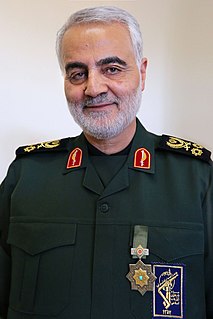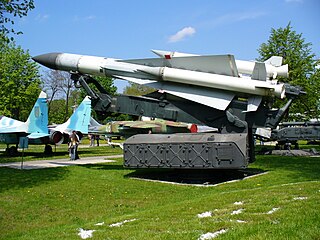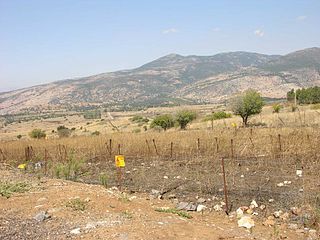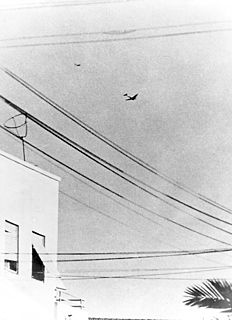It has been requested that the title of this article be changed to Operation House of Cards . Please see the relevant discussion on the discussion page. Do not move the page until the discussion has reached consensus for the change and is closed. |
The May 2018 Israel–Iran clashes were a series of short military confrontations between Israeli and Iranian forces in Syria. [5] On 10 May 2018 the Israeli military stated that Iranian forces in Syria launched 20 rockets against Israeli army positions on Western Golan Heights. [6] [7] [8] [9] [10] [11] [12] [13] [14] Syrian Observatory for Human Rights said that the attack occurred after Baath, a town in the demilitarised zone, was bombarded by Israeli forces. [12] [15] According to the Israel Defense Forces (IDF) some missiles were intercepted by Israel's Iron Dome system, while some fell short in Syrian territory. [16] Following this, Israel launched an extensive strike in Syria against Iranian targets, called Operation House of Cards (Hebrew : מִבְצָע בֵּית הַקְלָפִים, mivtza beit haKlafim) targeting Iranian military bases in Syria. [17] [18] Syria state media called the attacks an act of Israeli aggression on Syrian territories. [19] Iran denied Israeli claims, stating it had neither fired rockets against Israel nor had any military bases in Syria. [20] During the operation, the Israel Air Force destroyed a number of Syrian air defense batteries, including a Pantsir-S1 system, a S-75 Dvina system, a S-200 missile system radar, and a Buk missile system. [4]

Israel, officially the State of Israel, is a country in Western Asia, located on the southeastern shore of the Mediterranean Sea and the northern shore of the Red Sea. It has land borders with Lebanon to the north, Syria to the northeast, Jordan on the east, the Palestinian territories of the West Bank and Gaza Strip to the east and west, respectively, and Egypt to the southwest. The country contains geographically diverse features within its relatively small area. Israel's economic and technological center is Tel Aviv, while its seat of government and proclaimed capital is Jerusalem, although the state's sovereignty over Jerusalem has only partial recognition.

Iran, also called Persia, and officially the Islamic Republic of Iran, is a country in Western Asia. With over 81 million inhabitants, Iran is the world's 18th most populous country. Comprising a land area of 1,648,195 km2 (636,372 sq mi), it is the second largest country in the Middle East and the 17th largest in the world. Iran is bordered to the northwest by Armenia and the Republic of Azerbaijan, to the north by the Caspian Sea, to the northeast by Turkmenistan, to the east by Afghanistan and Pakistan, to the south by the Persian Gulf and the Gulf of Oman, and to the west by Turkey and Iraq. The country's central location in Eurasia and Western Asia, and its proximity to the Strait of Hormuz, give it geostrategic importance. Tehran is the country's capital and largest city, as well as its leading economic and cultural center.

The Golan Heights, or simply the Golan, is a region in the Levant, spanning about 1,800 square kilometres (690 sq mi). The region defined as the Golan Heights differs between disciplines: as a geological and biogeographical region, the Golan Heights is a basaltic plateau bordered by the Yarmouk River in the south, the Sea of Galilee and Hula Valley in the west, the Anti-Lebanon with Mount Hermon in the north and Wadi Raqqad in the east; and as a geopolitical region, the Golan Heights is the area captured from Syria and occupied by Israel during the Six-Day War, territory which Israel effectively annexed in 1981. This region includes the western two-thirds of the geological Golan Heights and the Israeli-occupied part of Mount Hermon.
Contents
The clash came during rising tensions between Israel and Iranian forces in Syria, including threats by the leader of Iran's Quds Force in Syria, Qasem Soleimani, to attack Israel. [21] The incidents also came just a day after the US announced it was withdrawing from the Iranian nuclear deal. [22]

The Quds Force is a unit of Iran's Revolutionary Guards (IRGC) directed to carry out unconventional warfare and intelligence activities and responsible for extraterritorial operations. It is commanded by Major General Qasem Soleimani. The Quds Force supports non-state actors in many foreign countries that include Lebanese Hezbollah, Hamas and Palestinian Islamic Jihad in the Gaza Strip and the West Bank, Yemeni Houthis, and Shia militias in Iraq, Syria, and Afghanistan. The United States has designated the Quds Force a supporter of terrorism since 2007.

Qasem Soleimani is an Iranian Major General in the Islamic Revolutionary Guard Corps (IRGC) and since 1998 commander of its Quds Force—a division primarily responsible for extraterritorial military and clandestine operations.
On May 8, 2018, the United States withdrew from the Joint Comprehensive Plan of Action.













